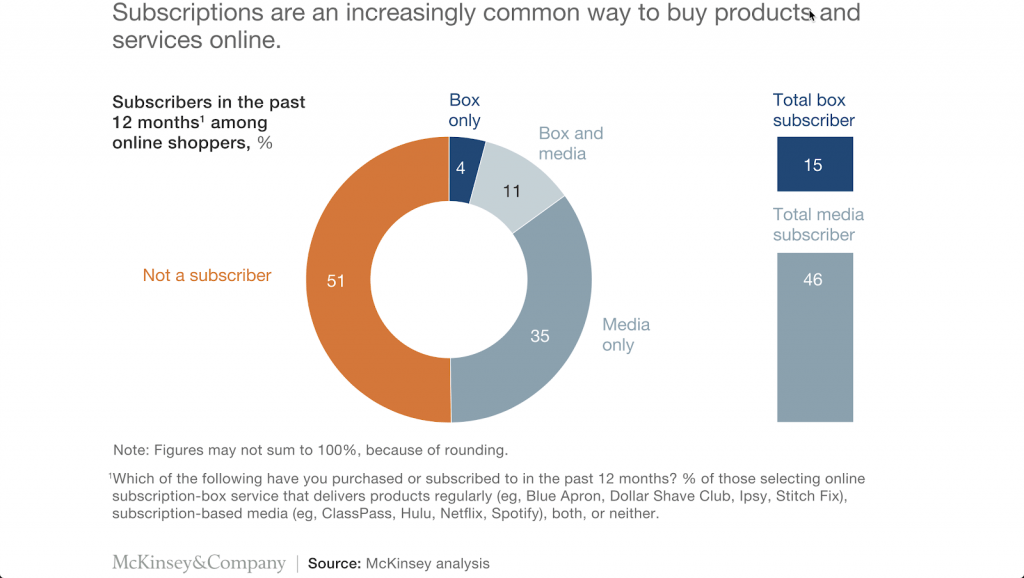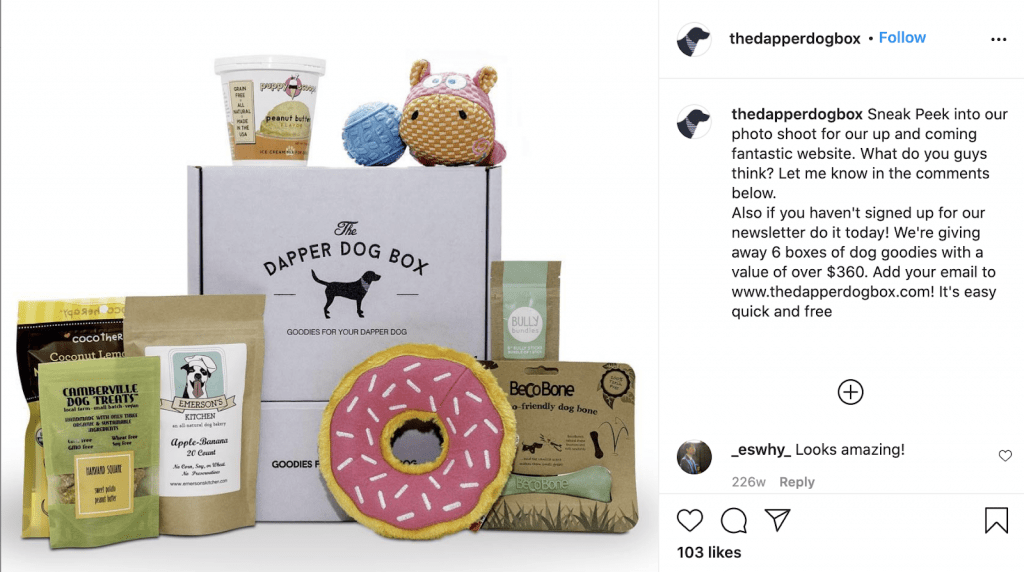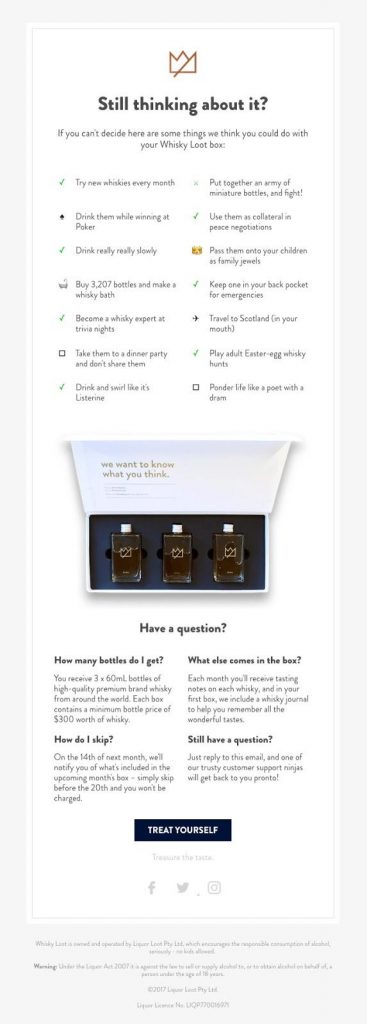As we all know, eCommerce can be competitive, with high churn rates. For starters, people love a subscription box because it gives them a convenient and personalized shopping experience at a fraction of the price they’d otherwise spend buying these items individually.
In fact, a study done by McKinsey shows that 15% of online shoppers are members of at least one subscription box program.
And it’s not just established stores that are benefitting from implementing a subscription box program. This business model helped startups like The Dollar Shave Club to quickly scale in one of the fastest and highly competitive industries today.
Despite facing competition from established brands like Gillette and Schick, The Dollar Shave Club’s decision to use the subscription box business model quickly made it a household name – so much that it clinched 48.6% of the market three years from launching.
In this post, we’ll let you in on everything we know about subscription box programs, why they work, and how you can successfully launch one for your eCommerce business.
Why Do Subscription Box Programs Work?
1. They Allow You to Offer More for Less
First and foremost, a subscription box program works because of what it gives to your consumer. For one thing, it was found that consumers are less likely to buy something if they have too many choices.
Offering fewer choices assures customers that you’ve made the best choice for them by curating precisely what they need while eliminating indecisiveness and risk of buyer’s remorse. It’s also the most convenient option for most consumers, saving them time and energy looking through or purchasing individual products themselves.
For the eCommerce owner, it means a chance to get consistent revenue from retained customers and can even be a way to increase average order value – as opposed to sticking with typical direct-to-consumer retail. It may also be a great way to get loyal customers from the very first purchase, as you turn your brand into a regular part of your consumers’ lives.
2. They Build a Sense of Anticipation
Remember when you saw a package waiting at your doorstep when you got home from work? Chances are you felt thrilled seeing the box there, even when you had an idea what’s inside.
A 2019 Clutch survey reported that 54% of respondents were subscribed to a subscription box service, mostly for the sake of convenience and novel experiences. Indeed, some subscription box services, like razor blade refills or packs of coffee, are convenient for consumers who want to avoid shopping for items they continuously use. Consumers are also more likely to be excited by their subscriptions because of the thought of receiving something new.
The popular service Birchbox, for instance, is a subscription box service that mails customers new cosmetic and grooming product samples each month. The products included in each box may be from popular brands, up-and-comers, and even undiscovered gems curated for the customers’ specific tastes.
Birchbox’s Black-Owned Brands Subscription Box gives its customers the chance to discover and support African-American brands with products formulated for their skin.
This builds excitement for consumers. What products will they get this month? What’s going to be different? Will they receive first dibs on an exclusive new brand that hasn’t hit the market yet?
And even if they’ve opted into a subscription service that sends the same items each month, such as product refills, there’s no discounting the anticipation and excitement one feels when receiving a package in the mail.
3. They Increase Customer Loyalty
Several studies show that a personalized shopping experience like a subscription box program helps build loyalty among your customers, which will, in turn, increase sales revenue by up to 30%.
One reason is that your customers are emotional buyers.
Think about it: when customers leave reviews about a recent purchase, like this one from Blue Apron’s Facebook page, much of what they write focuses on their emotions resulting from their online shopping experience.
Another reason is that your customers expect you to treat them with importance and value, whether they buy from your physical or online store. As many as 82% of customers say that they’ll stop doing business with a brand if they have a terrible shopping experience.
On the other hand, when you successfully give your customers a personalized shopping experience and make them feel like they’re royalty, 52% of them will become loyal customers.
And this is where launching a subscription box program comes in.
Subscription box programs can meet these customer expectations by providing them with a personalized shopping experience – from the products to the packaging and even the frequency.
Australian-based Vitable’s subscription program is a perfect example of this. Subscribers are given a short quiz that asks questions about their current health goals, dietary preferences, and lifestyle.
Even the packaging has been personalized to include the subscriber’s name along with a simple note. The font Vitable chose for printing customers’ names gives the box an added personal touch.
7 Steps to Launch a Subscription Box Program
Now that you see why subscription box programs work, you may be wondering how to add a subscription product to your existing store. Here’s a step-by-step guide to integrating your first subscription box program successfully.
Step 1: Identify Which Products to Group Together
First and foremost, make sure the items make sense; the best way to do this is by clearly understanding your customers’ buying behaviors and patterns.
Take Wine Down’s subscription box, for example.
Notice that the subscription box also includes an assortment of cold cuts, cheeses, crackers, and fruits, depending on the type of wine each subscriber selects. That’s because these are staples that most wine lovers enjoy having along with a glass of wine.
K-Beauty’s monthly subscription box is another great example.
Here, they grouped all the different skincare products a subscriber will need for the 10-step Korean skincare routine, based on their specific skin type. In this example, the products are chosen explicitly for subscribers with dry skin.
Step 2: Set Your Price
Pricing is an important step to consider. Remember that you’ll be billing consumers every month for their subscription, and that’s a monthly expense for them. You’ll want your subscription fee to feel more than worth it to consumers, so you can get away with charging lower margins per product.
You may also give discounts if customers subscribe for a set minimum period, for example, three months or even a year. This way, you can provide better prices while ensuring that customers don’t cancel after the first month.
The value of each item individually may affect the overall price of the entire set. So if you want to strike a balance between high-ticket items and affordability for customers, you can always include fewer items per box each month.
Bonus Content: The Ultimate Price Increase Strategy for eCommerce
Step 3: Have the Right Tools in Place
A subscription box program entails more logistics than a software subscription. You’ll need to manage your inventory alongside orders while also making sure you’re only sending boxes to customers with a recurring or non-canceled subscription.
Fortunately, many tools can help make the process much more comfortable than it sounds. For one thing, some of the best eCommerce platforms let you integrate with payment providers who support subscription payments. They may also have built-in inventory management, allow you to integrate with third-party tools for the same, or support integrations for invoicing.
Part of having the right tools also includes your marketing stack. In the next few sections, we’ll show you some of the things you should plan for in actual campaigns, as well as tools you can use to accompany each marketing stage.
Step 4: Design Your Packaging
As mentioned earlier, subscription box programs are successful when they deliver a great customer experience. And the packaging of your subscription box is a big part of that experience because it’s the first thing your customers will see.
A well-designed subscription box should be an extension of your eCommerce business’s brand identity. Not only should it contain your logo and brand colors, but it also evokes your brand’s overall personality.
At the same time, you’d want your packaging to be sturdy enough to protect the products inside during transit, especially if you’re shipping out fragile and/or perishable items.
An excellent example of a winning subscription box packaging design is from Eat2Explore.
The global map design on the top cover of the subscription box is dotted with pictures of different food items, which clearly and cleverly visualizes the eCommerce store’s slogan printed on the box’s lid. This is carried over to the packaging of the various items included inside the box, which reminds you of those trail mixes you take with you while camping or hiking.
The colorful, cartoon-like drawings also make this subscription box appealing to both kids and adults, which appropriately encapsulates their goal of making each mealtime a culinary adventure for the whole family.
Bonus Content: Upgrade Your Unboxing Experience to Pro Level
Step 5: Plan Your Marketing Campaigns
Now you’ll want to carefully think through your marketing plan for your subscription box service.
If you’re already doing direct-to-consumer or retail, you can leverage your existing market and create campaigns around these consumers. And even if you’re starting from scratch, there are some useful tactics you can use to make sure your subscription box program begins on the right foot and stays sustainable.
Here, we’ll walk you through some strategies and tips for planning each stage of your marketing campaigns.
1. Pre-Launch
Your overall goal for pre-launch marketing is to build hype around your subscription box program so that your target customers will be willing to buy the moment it launches. This is where you can go on platforms like Instagram or Facebook to get people excited about what’s coming.
The Dapper Dog Box, for example, posted several sneak peek photos like this one on its Instagram account, giving its target customers a glimpse of what they’ll get once the subscription box launches. This helped get the word out and generate a buzz around the brand.
To make sure you get as many new subscribers as possible, consider doing surveys to understand your customers’ preferences and interests. This way, you can create a subscription box program that genuinely compels consumers to opt into your subscription the moment it launches.
As you get closer to launch, you may want to work with influencers and other key people in your market who can help build hype and awareness. Send an exclusive box set that teases what anyone can expect from your actual subscription boxes in the future, and even consider a pre-sale period. Users can make their first payment to the program early in exchange for a special discount or gift.
Creating a landing page with a discount offer can help you collect leads that you can reach out to via email when you launch your subscription box program.
If you can, get the word out on PR channels. Aim to get your new subscription featured in publications or popular communities within your market.
2. Actual Launch
During your actual launch, your goal is to make sure customers are so impressed by their first experience that they’ll be more than willing to share that experience with their friends and networks.
Unboxing videos like this one done by The Crafty House UK for the PaperGang October 2020 Stationery Subscription Box can help generate a sense of FOMO among its viewers, encouraging them to join.
You’ll also want to make sure new leads will be able to book their subscription as soon as possible on your website. Focus on driving traffic to your eCommerce store by making all your channels lead directly to your site.
3. Post-Launch
The goal after your launch is to keep existing customers subscribed to the program. While churn is expected for a certain percentage of consumers, you can still implement as many strategies and tactics as possible to keep them happy and subscribed for as long as possible.
For instance, invest in your customer support channels to make sure you get back to any customer concerns, queries, and even objections.
Whiskey Loot, for example, automatically sends out an abandoned cart email that highlights not just the benefits you’ll get from joining its subscription box program but what you’ll be missing out on if you choose not to join.
Also, make sure you can collect feedback and reviews about your subscription boxes. Each month, ask customers what they liked and where they felt you missed the mark. This way, you can collect real data from customers.
Step 6: Establish a Scalable Workflow for Processing Your Orders
This is perhaps the most crucial step of launching a subscription box program because it involves making sure that your subscribers receive their boxes on time. The last thing you’d want is to get bombarded with complaints from disappointed subscribers.
That’s why it’s vital to equip your team with the right tools to ensure that you get the job done.
One tool to invest in is a reliable project management platform. This will serve as the central hub for all of the activities you and your team will be doing. At the same time, you can quickly identify roadblocks like delays in shipment so that you can address this promptly and avoid giving your subscribers a horrible experience.
Zapier is another great tool to use, which ensures you process your subscription box orders efficiently. It helps automate various stages of your workflow process across different devices and platforms, even if they don’t integrate seamlessly.
What’s great about Zapier is that you can program each workflow (called “zap”) to handle multiple steps, minimizing the risk of human error.
Step 7: Regularly Evaluate Your Subscription Box Program’s Performance
Scheduling periodic evaluations of your subscription box program allows you to find areas to improve and new opportunities to serve your subscribers better.
For example, if you’re running a makeup subscription box program and you’ve consistently received not-so-stellar feedback on a specific brand, you might want to consider removing this brand from your inventory.
On the other hand, if you’ve been receiving lots of queries about when you plan on shipping to a specific country, you might want to start looking into the possibility of expanding your subscription box program to cater to them.
Key Takeaways
In this “new normal” where many customers are tightening their budget belts, launching a subscription box program can help you generate consistent sales for your online store and move all that inventory you still have.
The steps shared in this article can help you launch a subscription box program no matter what products you’re selling. The key here is to allow your customers to customize their own subscription boxes based on their preferences.
Above all, invest time and energy to keeping your subscribers happy by listening to their feedback and suggestions. This makes your customers feel valued and appreciated, encouraging them to keep their subscriptions (and eCommerce business) going.

Kevin Payne is a content marketing consultant that helps software companies build marketing funnels and implement content marketing campaigns to increase their inbound leads.
Recommended articles
 Facebook Ads for eCommerce: 16 Strategies, Examples & Tips
Facebook Ads for eCommerce: 16 Strategies, Examples & Tips
 How to Build a Winning eCommerce Ads Strategy
How to Build a Winning eCommerce Ads Strategy
 Google Ads for eCommerce: Everything You Need to Know
Google Ads for eCommerce: Everything You Need to Know
 10X Your Traffic with PPC Management Software
10X Your Traffic with PPC Management Software
Comments
Powered by Facebook Comments










